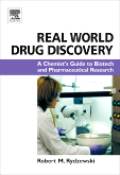
Real world drug discovery: a chemist's guide to biotech and pharmaceutical research
Rydzewski, Robert
Drug discovery increasingly requires a common understanding by researchers ofthe many and diverse factors that go into the making of new medicines. The scientist entering the field will immediately face important issues for which his education may not have prepared him: project teams, patent law, consultants,target product profiles, industry trends, Gantt charts, target validation, pharmacokinetics, proteomics, phenotype assays, biomarkers, and many other unfamiliar topics for which a basic understanding must somehow be obtained. Even the more experienced scientist can find it frustratingly difficult to get an overview of the many factors involved in modern drug discovery and often only after years of exploring does a whole and integrated picture emerge in the mind of the researcher."Real World Drug Discovery: A Chemists Guide to Biotech and Pharmaceutical Research" presents this kind of map of the landscape of drug discovery. In a single, readable volume it outlines processes and explains essential concepts and terms for the recent science graduate wondering what to expect in pharma or biotech, the medicinal chemist seeking a broader and more timely understanding of the industry, or the contractor or collaborator whose understanding of the commercial drug discovery process could increase the value of his contribution to it.The key features include: interviews with well-known experts in many of the fields involved, giving insightful comments from authorities on many of the sub-disciplines important to cutting edge drug discovery; helpful suggestions gleaned from years of experience in biotech and pharma, which represents a repository drug discovery 'lore' not previously available in any book; 'Periodic Table of Drugs' listing current top-selling drugs arranged by target and laid out so that structural similarities and differences are plain and clear, with regular updates available at the book's website; and, extensive use of diagrams to illustrate concepts like biotech startup models, preteomic profiling for target identification, Gantt charts for project planning, etc. INDICE: Chapter 1 – The Drug Discovery Business to Date I. Introduction II. The Past A. Pharma Roots B. Biotech is Born C. The Genomics Revolution III. Current Economics?Problems A. Cost of Drug Development B. The Productivity GapC. Market Withdrawals D. Generic Competition IV. Current Economics?Solutions A. Pharma Profits and Market Expansion B. Mergers and Acquisitions C. Biotech Clinical Candidates to Pharma D. Academic Contributions E. Global Outsourcing F. Blockbusters and Orphan Drugs G. Repurposing H. Chiral Switching I. Combination Therapeutics J. Reformulation V. Summary References Chapter 2 – The Drug Discovery Business to Come I. Introduction II. New Models for Pharma A. R&D Minus R B. D Plus R C. Smaller is Better D. Specialty Drugs E. Pricing Pressuresand Price Controls III. New Models for Academia and Biotech – A. Translational Research B. The Standard Biotech Model C. ?Is it a project or a company?? D.Leaner, Meaner Startups E. Biotech Alternatives IV. New Technologies A. S-Curves and Expectations B. Genomics Redux C. Personalized Medicine D. Pharmacogenomics E. Other ?Omics? F. The Adoption of Personalized Medicine V. Summary References Chapter 3 – Industrial Considerations I. Intellectual Property .. 1 A.The Value of New Ideas 1. Invention Disclosures 2. Notebooks and Data Recording 3. Avoiding Inappropriate Disclosure B. Patents 1. Introduction and Definition 2. Patent Requirements a. Novelty, Priority, and Prior Art b. Unobviousness c. Utility 3. Reading and Searching Patents a. Some Preliminaries b. Patent Anatomy c. Locating Information in Patents 4. Inventorship II. Outside Resources A. Consultants B. Academic or Government Research Agreements C. Big Company-Small Company Collaborations III. The New Drug R&D Process A. Target Identification B. Lead Identification C. Lead Optimization D. Preclinical E. Stages inClinical Development F. What Are the Odds? References Chapter 4 – How Things Get Done: The Project Team I. Introduction II. The Project Team A. The ProjectGoal 1. Compound Validation Goals 2. Target Validation Goals B. Project Team Organization 1. The Matrix Management System a. Day-to-Day Supervision b. Target Compounds c. Progress Reporting d. Performance Evaluations 2. Project Team Roles a. Project Team Leader b. Project Team Member c. Project Team Representative d. Project Team Manager C. Project Team Meetings 1. Meeting Scheduling 2.The Meeting Agenda 3. Meeting Notes 4. Action Items 5. Project Planning ToolsIII. Conclusions A. Summing Up B. Is It Really Best? C. The Benefits References Chapter 5 – Project Considerations I. Introduction II. Established Targets III. Established ?Tough Targets? IV. Novel Targets A. Identifying New Targets B. Target Validation 1. Levels of Validation 2. Target Validation Tools a. Knockouts and Knock-Ins b. Antisense Oligonucleotides c. RNAi d. Antibodies e. Aptamers f. Small Molecules C. Working on Novel Target-directed Projects V. Targets Arising from Phenotype or High-Content Screening A. Phenotype Screening Versus Target Screening B. Elucidation of Phenotype Targets VI. In Conclusion References Chapter 6 – Hit Generation I. Introduction II. Definitions III. Groups Involved IV. High-Throughput Screening A. History B. Myths and Truths about HTS V. Approaches to Hit Generation A. Random or Non-directed Methods B. Screening of Synthetic Compound Collections C. Screening of Combinatorial DiversityLibraries D. Fragment Screening 1. Detecting Fragment Binding 2. Optimizing Fragment Hits E. Screening of Natural Products and DOS Libraries F. Directed orKnowledge-based Methods 1. Methods Based on Endogenous Ligands or Substrates 2. Methods Based on Other Leads G. Computational Methods References... etc.
- ISBN: 978-0-08-046617-0
- Editorial: Elsevier
- Encuadernacion: Cartoné
- Páginas: 528
- Fecha Publicación: 01/09/2008
- Nº Volúmenes: 1
- Idioma: Inglés
